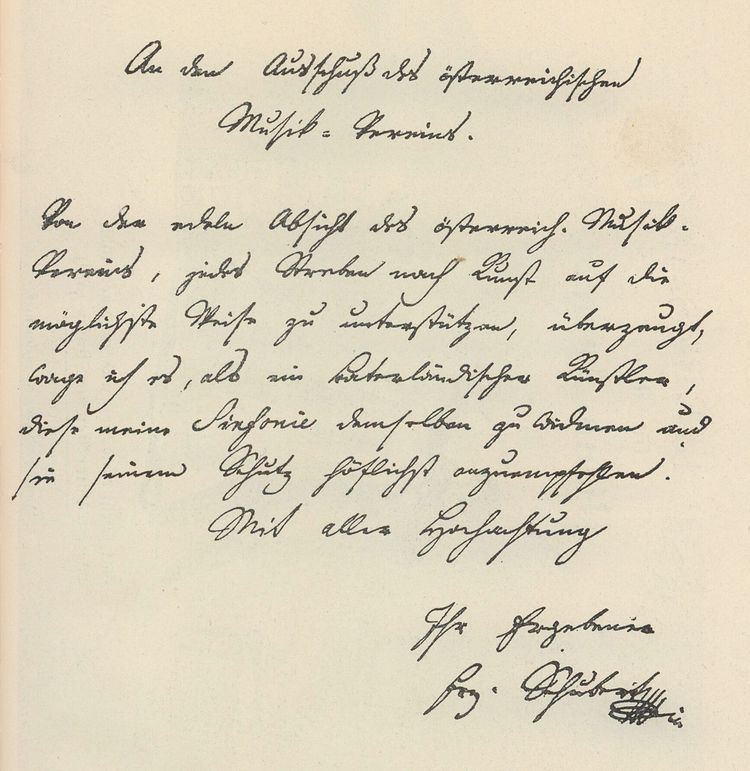 | ||
The Symphony No. 9 in C major, D. 944, known as the Great (published in 1840 as “Symphony No. 7 in C Major”, listed as No. 8 in the Neue Schubert-Ausgabe), is the final symphony completed by Franz Schubert. Originally called The Great C major to distinguish it from his Symphony No. 6, the Little C major, the subtitle is now usually taken as a reference to the symphony's majesty. Unusually long for a symphony of its time, a typical performance of The Great takes around 55 minutes, though it can also be played in as little as 45 minutes by employing a faster tempo and not repeating sections as indicated in the score.
Contents
Composition and early reception
For a long time, the symphony was believed to be a work of Schubert’s last year, 1828. It was true that, in the last months of his life, he did start drafting a symphony – but this was the work in D major now accepted as Symphony No. 10, which has been realized for performance by Brian Newbould. In fact, it is now known that the 'Great' was largely composed in sketch in the summer of 1825: that, indeed it was the work to which Schubert was referring in a letter of March 1824 when he said he was preparing himself to write 'a grand symphony' (originally listed as Gmunden-Gastein symphony, D 849 in the Deutsch Catalogue). By the spring or summer of 1826 it was completely scored, and in October, Schubert, who was quite unable to pay for a performance, sent it to the Gesellschaft der Musikfreunde with a dedication. In response they made him a small payment, arranged for the copying of the orchestral parts, and at some point in the latter half of 1827 gave the work an unofficial play-through (the exact date and the conductor are unknown) – though it was considered too long and difficult for the amateur orchestra of the conservatory.
A recent hypothesis suggests that the symphony may have received its first performance on 12 March 1829 in a Concert spirituel at the Landständischer Saal in Vienna. The evidence for this hypothesis is slender, however, and it contradicts contemporary sources which prove that Schubert's Symphony No. 6 (also in C major) was performed at this instance. In 1836 Schubert's brother Ferdinand attempted to perform the final movement alone, yet there is no proof that it was actually played in public.
In 1838, ten years after Schubert's death, Robert Schumann visited Vienna and was shown the manuscript of the symphony at the Gesellschaft der Musikfreunde by Ferdinand Schubert. He took a copy that Ferdinand had given him back to Leipzig, where the entire work was performed publicly for the first time by Felix Mendelssohn at the Leipzig Gewandhaus on 21 March 1839. Schumann celebrated the event in the Neue Zeitschrift für Musik with an ecstatic article in which, in a phrase destined to become famous, he hailed the symphony for its 'heavenly length'.
The symphony, however, was found to be very difficult for orchestras to play because of its extremely lengthy woodwind and string parts. When taking the symphony to Paris in 1842 and London in 1844, Mendelssohn found orchestras completely unwilling to play the symphony; in London, the violinists collapsed in laughter when rehearsing the second subject of the finale.
Numbering
There continues to be some controversy over the numbering of this symphony, with German-speaking scholars sometimes numbering it as symphony No. 7, the most recent version of the Deutsch catalog (the standard catalogue of Schubert's works, compiled by Otto Erich Deutsch) listing it as No. 8, and English-speaking scholars often listing it as No. 9.
Form
Following the standard symphonic form, there are four movements:
- Andante – Allegro ma non troppo — Piu Moto
- Andante con moto in A minor
- Scherzo. Allegro vivace Trio in C major/A major
- Finale. Allegro vivace
Often considered Schubert’s finest piece for orchestra, this symphony is also one of the composer’s most innovative pieces. Thematic development in the style of Beethoven is still present in the work, but Schubert puts far more emphasis on melody, which one might expect from the composer of some six hundred lieder. In fact, this new style prompted Robert Schumann to pursue his own symphonic ambitions. The symphony is scored for 2 flutes, 2 oboes, 2 clarinets in A and C, 2 bassoons, 2 horns in C, 2 trumpets in A and C, 3 trombones, timpani, and strings.
Beethoven had always used the trombone as an effect, and therefore very sparingly, or, in the case of his Ninth Symphony, also to double the alto, tenor, and bass parts of the chorus as was common in sacred music and opera at the time. However, in Schubert’s Unfinished Symphony and the Ninth Symphony, the trombones become essential members of the orchestra playing throughout the piece, and even receive important melodic roles.
